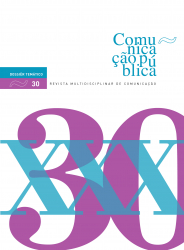Giving a Voice to Women Journalists in the Arab World
Challenges, Courage and the Sahafiyat
DOI:
https://doi.org/10.4000/cp.12553Keywords:
journalism, arab, women journalism, literary journalism, true storiesAbstract
When considering journalism from the Arab world, one is often faced with complex stories from a troubled region. For the western perspective it is easy to forget that the Arab region encompasses twenty-two countries and it is not reasonable to assert that conflicts and hostilities constantly affect the whole region. This study will focus on a number of journalists reporting on this reality, the challenges and the specificity of their craft. Afterwards, this study will focus on a recent publication that voices the Arab women journalists and their work in the region. By exploring the importance of this publication and their news reporting, this analysis hopes to address how their work contributes to dispel stereotypes and misconceptions. At the same time this essay hopes to consider the value of their reporting as part of literary journalism while also arguing for its just place in academia.
Downloads
References
Allam, H. (2019). The Woman Question. In Z. Hankir (Ed.). Our Women on the Ground. (pp. 3-12). Harvill Secker.
Allam, R. (2008, June, 2). Countering the Negative Image of Arab Women in the Arab Media: Toward a “Pan Arab Eye”. Media East Institute. https://www.mei.edu/publications/countering-negative-image-arab-women-arab-media-toward-pan-arab-eye-media-watch
Anderson, S. (2016, August, 10). Fractured Lands: How the Arab World Came Apart. The New York Times Magazine. www.nytimes.com/interactive/2016/08/11/magazine/isis-middle-east-arab-spring-fractured-lands.html
Anderson, S. (2017). Fractured Lands: How the Arab World Came Apart. Anchor Books.
Arraf, J. (2019). Maps of Iraq. In Z. Hankir (Ed.). Our Women on the Ground. (pp. 59-68). Harvill Secker.
Attalah, L. (2019). On a belated Encounter with Gender. In Z. Hankir (Ed.). Our Women on the Ground. (pp. 45-56). Harvill Secker.
Carrasco, T. (2012). A Estrada da Revolução. Oficina do Livro.
Conover, T. (2007). Participatory Reporting: Sending Myself to Prison. In M. Kramer & W. Call (Ed.). Telling True Stories. (pp. 35-39). Penguin Books.
Hankir, Z. (2019). Introduction: Sahafiya. In Z. Hankir (Ed.). Our Women on the Ground. (pp. xi-xxii). Harvill Secker.
Hassan, H. (2019). Hull & Hawija. In Z. Hankir (Ed.). Our Women on the Ground. (pp. 97-108). Harvill Secker.
Helal, E. (2019). Just Stop. In Z. Hankir (Ed.). Our Women on the Ground. (pp. 111-24). Harvill Secker.
Kramer, Mark (1995). Breakable Rules for Literary Journalists. In Norman Sims and Mark Kramer (Ed.). Literary Journalism (pp. 21-34). Ballantine Press.
Moura, Paulo (2018). Uma Casa em Mossul. Objectiva.
Malas, N. (2019). Bint el-Balad. In Z. Hankir (Ed.). Our Women on the Ground. (pp. 80-96). Harvill Secker.
Ronk, L. & Rothman, L. (2015, September, 11). This is What Europe’s Last Major Refugee Crisis Looked Like. Time. www.time.com/4029800/world-war-ii-refugee-photos-migrant-crisis/
Williams, H. (2014, June, 14). In Captured Iraqi city of Mosul, residents welcome ISIS. CBS News. https://www.cbsnews.com/news/in-captured-iraqi-city-of-mosul-residents-welcome-isis/
BookTV. (2019, August, 19). Zahra Hankir, “Out Women on the Ground” [Video file] https://www.youtube.com/watch?v=As26lwieirA
PBS NewsHour. (2019, August, 26). How Arab women are changing the face of journalism in the Middle East [Video file]. https://www.youtube.com/watch?v=jET8JNnl1FM
FRANCE 24 English. (2019, November, 6). “Our women on the ground”: Zahra Hankir gives a voice to Arab female journalists [Video file] https://www.youtube.com/watch?v=Cgb5GL0uJgQ.
Downloads
Published
Issue
Section
License
Copyright (c) 2021 Direitos do Autor (c) 2021

This work is licensed under a Creative Commons Attribution-NonCommercial 4.0 International License.
Os conteúdos da Comunicação Pública estão licenciados com uma licença Creative Commons - Atribuição-NãoComercial 4.0 Internacional.


